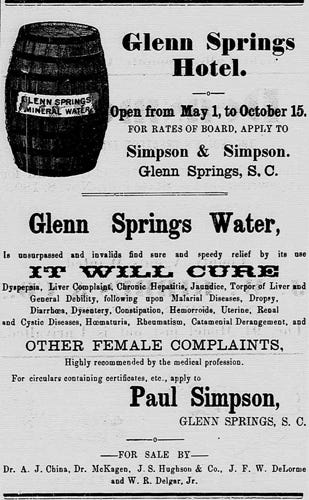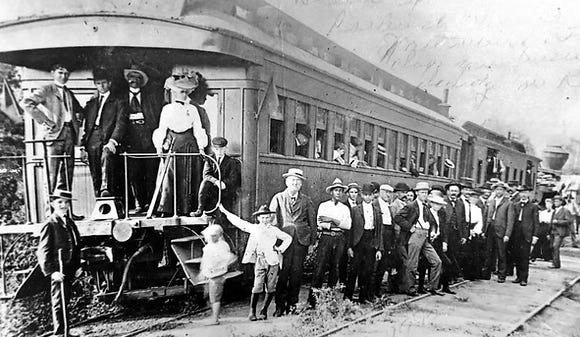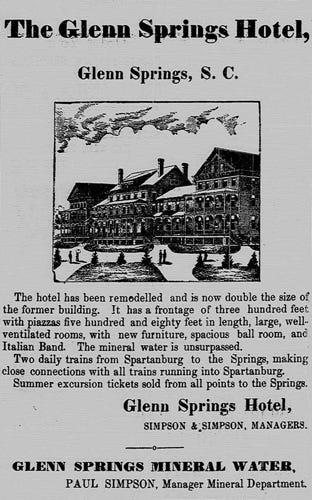#150: Taking the Waters: South Carolina's Forgotten Spa Towns + Genealogy Workshop at Walnut Grove Plantation
For South Carolina history lovers far and wide! Published weekly on Monday mornings. Enjoy weekly SC history articles, upcoming SC historical events, and other South Carolina recommendations.
Dear readers,
Happy 150th newsletter!! Woohoo!
I can’t believe it. I started this newsletter in February 2024 as a way to delve deeper into the incredible history of the beautiful state that I have adopted as my home. I have learned so much and met so many amazing subscribers along the way. Thank you for subscribing and being a part of the newsletter!
I am in the mood these days for “warm weather topics” and was drawn to learning more about these forgotten South Carolina spa towns of the 19th and early 20th century. So fascinating! It makes me want to jump in a lake.
What are you doing this summer to escape the heat? Does your family go to any special resorts or historic places in South Carolina or across the region? Reply to this email and share! I’d love to hear.
Sincerely,
Kate
(Writing from Greenville, SC)
Support the SC History Newsletter by considering heritages teas (inspired by South Carolina and American history!) from our fantastic sponsor Oliver Pluff & Co. — click on their beautiful ad below! :)
➳ Housekeeping for new subscribers!
New friends! There are over 100 previous SC History newsletters on topics ranging from the founding of Charleston, sunken Confederate submarines, railroad tunnels filled with blue cheese, and more! See our archive here!
Send me your comments or topic ideas: I love it when subscribers write to me! Have a SC History topic or question you’d like for me to write about? Have additional ideas or feedback? Just reply to this email and let me know!
Join us on social: Keep the conversation going and join over 100 other subscribers by becoming a member of our SC History Newsletter Facebook Community here!
If your email “cuts off”: In your email app or website, if my emails “cut off” for you, please click the title of the email and it will take you to the full post on the Substack. I don’t want you to miss any content!
Love the SC History Newsletter? Please click the button below to share with a friend!
➳ Featured Upcoming SC History Events
📜 Rewriting a Rewritten Narrative: Researching and Teaching the History of Slavery at Walnut Grove Plantation - presented by Lutz Wright
🗓️Friday, June 27th, 12:30 - 1:30 pm
📝 Chapman Cultural Center
📍Spartanburg, SC
💻 Website
From the event website:
“Join us to explore the evolving narrative of slavery at Walnut Grove Plantation. Learn how archaeology, census records, slave narratives, and wills are helping uncover the lives of those once left out of the story—and how this research is reshaping the way we teach and interpret the past.
This important presentation and conversation will challenge myths, broaden perspectives, and highlight the necessity of telling a fuller, more inclusive history.”
➳ 🗓️ Paid subscribers get access to my SC History Events Calendar that organizes all the upcoming SC history events I have discovered. Please let me know if you’d like to add an event to the calendar! Reply to this email to send me your events.
➳ Taking the Waters: South Carolina's Forgotten Spa Towns
In the days before beach trips and lake houses, for wealthy families in South Carolina, summer vacation often meant a journey to a local mineral spring. These natural retreats offered more than just cooler mountain air — they promised healing, elegance, and social prestige! Whether sipping mineral water believed to cure ailments, networking (or matchmaking) with other families, or dancing at resort balls, the wealthy elite of the Carolinas made these spa towns essential destinations in the 1800s. Today, the names Glenn Springs and Chick Springs are all but forgotten outside their counties (though it bears noting that I live only a few hundred feet away from Chick Springs Road here in Greenville!). But in their heyday, they were the beating heart of summer society in South Carolina.
Glenn Springs: Spartanburg County's Season of Elegance
Located in the rolling hills of Spartanburg County, the town of Glenn Springs rose to fame in the mid-1800s as a mineral springs resort.
According to local legend, Native Americans were the first to discover the healing powers of the mineral water found in the area. It is said that a Native American warrior was gravely ill and made a “miraculous recovery” after drinking from the waters.
The water, rich in minerals like calcium sulfate, sodium sulfate, calcium carbonate and more, was believed to cure everything from rheumatism to indigestion. It was called the “True Elixer of Life.”
Some sources say that General George Washington stopped at the springs on his way to Savannah as a guest of John King, a member of Washington’s Guard.
In 1825, a man named John B. Glenn purchased the land around the mineral spring and first opened an inn, which quickly became so popular, that Glenn eventually built a large hotel that would become a regional landmark.
At its peak, the resort rivaled the more famous Virginia springs and drew planters, politicians, and wealthy families from across the South.
The Glenn Springs Hotel was a grand three-story building with wraparound porches, ballroom, and fine dining. Guests at the hotel typically stayed for several weeks during the hot summer months, escaping the heat and illnesses of the Lowcountry and city life. Days were filled with leisurely walks, carriage rides, reading on the veranda, and taking the waters at prescribed times. Evenings brought social events — dances, concerts, and lectures.


The hotel’s register included the names of many prominent South Carolinians. The hotel became known as the “unofficial capital of South Carolina” because so many “judges, US senators, representatives, and state officials spent the summer with their families at Glenn Springs.”
The resort also played host to political conversations, courtships, and reunions. Several small cottages and boarding houses surrounded the hotel, creating a seasonal community. The town even had its own post office and telegraph connection at one point.
Walking to the mineral spring was a common ritual and visitors would often drink 15-30 glasses of the mineral water a day!
See the highly amusing Glenn Springs Water advertisement below. It reads that the Glenn Springs Mineral Water is “unsurpassed and invalids find sure and speedy relief by the use… IT WILL CURE…Dyspepsia, Liver Complaint, Chronic Hepatitis, Jaundice, Torpor of the Liver and General Debility, following upon Malarial Diseases, Dropsy, Diarrhea, Dysentery, Constipation, Hemorrhoids, Uterine, Renal and Cystic Diseases, Rheumatism, Catamenial Derangement, and….OTHER FEMALE COMPLAINTS…Highly recommended by the medical profession.”

The Glenn Springs Company bottled and “shipped its mineral water across South Carolina, the United States, and even parts of Europe. It was still being stocked in the U.S. Senate cloakroom as late as 1930.”
The Civil War interrupted Glenn Springs’ rise, but it recovered modestly in the decades after, until automobiles and modern medicine shifted health and travel trends.
In 1877 during the Reconstruction Era, the hotel changed ownership to Dr. John W. Simpson, who enlarged the hotel to be able to accommodate 500 guests. He also added a Presbyterian Church to the property in 1882.
According to the Glenn Springs Preservation Society, here is a glimpse of daily life at the hotel:
“A slice of nightly life: Entertainment was provided with nightly dancing to the orchestra in the ballroom, tennis court, tin pan alley billiard and card tables, bathing pool, shooting gallery, chess, croquet, and visits to nearby gold mines and Revolutionary War sites.”
The Glenn Springs Hotel was so popular that by 1894 it even had its own railroad. Operating on 10 miles of track from Glenn Springs to Pauline to Roebuck “on the Port Royal and Western Carolina, the line owned one locomotive, one combination car, and one passenger car. The train, pulled by wood-burning locomotive #1226, made one round trip a day in the summer and three times a week in the winter with a fare of seventy-five cents for adults and thirty-five cents for children.”

A few decades later, the Great Depression hit Glenn Springs hard and the resort never recovered from that trying time in its history.
Tragically, fire destroyed the grand hotel in 1941, marking the symbolic end of its golden age.
Today, only a few structures and a historical marker remain of the once grand resort.
Chick Springs: Greenville’s Glamorous Getaway
Just outside present-day Taylors in Greenville County, Chick Springs was one of the Upstate's most fashionable destinations in the mid-19th century.
Like at Glenn Springs, for centuries, the Cherokee Indians had recognized the healing powers of the mineral waters on the land.
A man named Dr. Burwell Chick, who was a physician in Newberry, SC, saw potential in the mineral spring. By 1840, Dr. Chick opened a hotel on the property near the spring and called it the Chick Springs Hotel. Dr. Chick had “tapped into a national trend” of mineral springs resorts as people sought both healing and leisure in beautiful natural settings.
Like Glenn Springs, the hotel drew guests from near and far seeking both health benefits and social mingling.
The price for one night’s lodging was $1. Dr. Chick charged half price for children, servants (likely enslaved workers), and horses.
One of the hotel’s prominent guests was South Carolina-born famous architect Robert Mills (who was the first designer of the Washington Monument, and later worked on the White House). Mills described the water at Chick Springs as smelling “like the washings of a gun barrel” and claimed it to be useful in “curing ring worms and other cutaneous disorders.”
The Chick Springs Hotel was described as a “large and commodious hotel.” Guests arrived by stagecoach or rail and followed daily routines that revolved around drinking the mineral water, enjoying music in the parlor, and strolling the manicured grounds. It was a place to be seen — especially for the young and eligible.

A visiting Catholic priest noted that the Chick Springs Hotel was a place largely “patronized by those in quest of pleasure or matrimonial alliances.”
A reporter in 1854 noted that the hotel was buzzing with activity and described:
“Five or six tables of whist parties below the piazzas, two or three card tables employed in the drawing room, two pianos accompanied by sweet voices, one billiard table, at which the balls were constantly cracking, a nine-pin alley, and a great many outsiders and lookers on busily engaged in smoking their cigars. Some were walking to the spring, and at the spring house some were pitching quoits for exercise after drinking the sulphur and chalybeate water.”
The reporter above also wrote about the hotel serving fresh watermelon to its guests and evening dances that often lasted until midnight.
The resort attracted hundreds of visitors at a time and boosted the local economy, farmers “for ten and twenty miles around” finding a market for their livestock and produce.
By 1847, the hotel was owned by Dr. Burwell Chick’s two sons. They sold the property in 1857. Five years later in November 2, 1862, the hotel caught fire and burned to the ground. Interestingly, in 1868, the Chick brothers repurchased the property, but then sold it to an Atlanta lawyer who “put up a new hotel and several cottages.”
The property changed ownership yet again in 1903, when it was purchased by a prosperous Greenville grocer and entrepreneur James A. Bull. Under Bull’s leadership, the hotel expanded and hosted 4,000 guests from May to October. The grounds expanded to included “pavilions, croquet grounds, tennis courts, and golf links.”

Like Glenn Springs, the Chick Springs Resort also bottled its water and incorporated as the Chick Springs Ginger Ale Company.
During the later part of the Chick Springs Hotel’s history, it was used as “a sanitarium, a military academy, and three distinct hotel structures.”
A disastrous civil works project led to the downfall of the resort when the South Carolina Highway Department constructed a highway through the resort’s park and bottling plant.
Like Glenn Springs, the Chick Springs resort has faded into memory. Today, the site is commemorated with a historical marker, and remnants of the spring are tucked behind suburban development — but old postcards and newspaper ads still hint at its former allure.
There is also a Chick Springs Historical Society (organized in 2008) that has a goal of preserving the 7 acres of land around the mineral spring and preserving it as a park.
Legacy and Reflection
The Glenn Springs and Chick Springs resorts belonged to an era when health, wealth, and society were all intimately tied together. To vacation at Glenn Springs or Chick Springs was not just about relaxation — it was about participating in a seasonal ritual of Southern aristocracy.
But for those curious about South Carolina’s past, these lost spa towns offer more than quaint stories — they reveal how the state’s elite shaped their identity, preserved their health, and built social networks long before sunscreen, bikinis, or beach chairs were ever part of the Southern summer.
With that being said, I have now written about many of South Carolina’s grand hotels in the heart of the state that have burned or been torn down. It hearts my heart to that these magnificent structures have vanished. While South Carolina seems to have amazing infrastructure and resorts for families to enjoy the coast and the beaches, I am saddened that there aren’t any grand hotels in the interior of the state anymore. We need a modern-day Dr. Chick or a John Glenn to build a new destination for families to embrace the natural beauty of the mountains and forests in the Upstate. Who’s with me? :)
If you voted just “OK” on the newsletter today, I want to hear from you! Reply to this email and send me your feedback. :)
➳ Sources — Taking the Waters: South Carolina's Forgotten Spa Towns
"Chick Springs." Wikipedia, https://en.wikipedia.org/wiki/Chick_Springs. Accessed 11 June 2025.
“Glenn Springs Hotel – Glenn Springs, South Carolina.” To Die For Images, 21 Aug. 2022, https://todieforimages.com/2022/08/21/glenn-springs-hotel-glenn-springs-south-carolina/. Accessed 11 June 2025.
“Healing Waters and Everlasting Roots: The Story of Glenn Springs, South Carolina.” Saving Places, https://savingplaces.org/stories/healing-waters-and-everlasting-roots-the-story-of-glenn-springs-south-carolina. Accessed 12 June 2025.
“Glenn Springs, South Carolina.” South Carolina Digital Newspaper Program Blog, University of South Carolina Libraries, 9 Aug. 2011, https://digital.library.sc.edu/blogs/newspaper/2011/08/09/glenn-springs-south-carolina/. Accessed 12 June 2025.
“History of Chick Springs.” Taylors TownSquare, https://www.taylorstownsquare.com/chick-springs. Accessed 11 June 2025.














